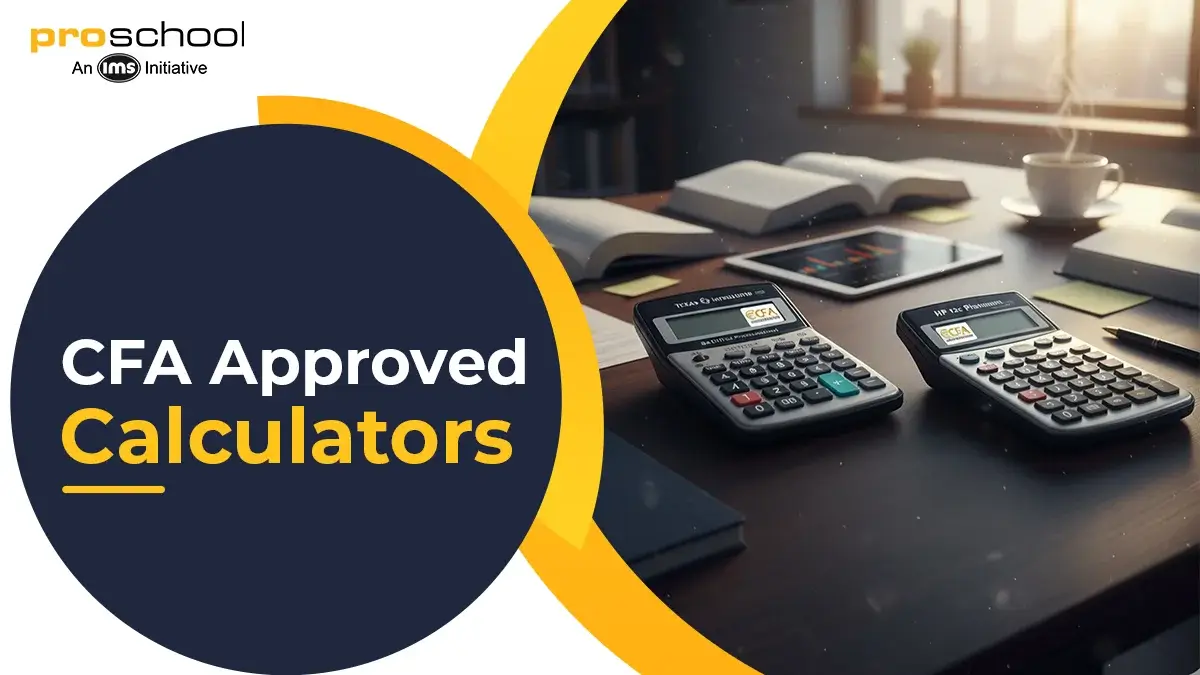Best Calculators Allowed for CFA Exam (2025 Edition)

Here's What We've Covered!
- Which Calculators Are Officially Allowed?
- Why the Texas Instruments BA II Plus Professional Calculator Is Preferred
- Comparing CFA-Approved Calculators
- Five Friendly Hacks to Get the Most from Your CFA Calculators
- Extra Practice: Five Keystroke Walk-Throughs
- How IMS Proschool Helps You Master Calculations with the Right Tool
- Conclusion
- FAQs
CFA calculators can make or break your score. In the CFA exam, your calculator isn’t just a tool. It’s your lifeline. One wrong model, and you might be left doing time-draining math by hand while everyone else races ahead.
Choose the right device and you’ll zip through NPV, IRR, and bond-pricing questions; choose the wrong one and you lose precious minutes. Because CFA Institute permits only a short list of devices, picking the best calculator allowed for cfa, and learning every key stroke ahead of time, should be part of your core study plan. This guide covers:
- All approved calculator models.
- Why do candidates worldwide prefer one model in particular?
- Side-by-side comparison of features, pros, and cons.
- Real-world tips to squeeze every second of speed from your device.
Which Calculators Are Officially Allowed?
Before you buy—or dust off—any device, pause and check the rules. CFA Institute’s policy is crystal clear: only two specific cfa calculators make it past the proctor’s desk. Bring anything else and you’ll be solving bond yields on scratch paper.
Let’s talk about those approved models, so you can choose between the popular Texas Instruments BA II Plus Professional calculator and the long-standing HP 12C line with total confidence.
CFA Institute’s 2025 policy names just two families of permitted devices:
| Approved Model | Variants You May Bring | Quick Policy Reminder |
| Texas Instruments BA II Plus | BA II Plus and Texas Instruments BA II Plus Professional calculator | Both pass security checks; clear memory (2nd → FV → 2nd → ENTER) before the exam begins. |
| HP 12C line | HP 12C Classic, HP 12C Platinum, 25th & 30th Anniversary editions | Same key layout since 1981; Platinum lets you toggle to algebraic entry if RPN scares you. |
Anything else—even a fancy Casio or a graphing TI-83—will be confiscated. Proctors also reserve the right to inspect and re-clear memory at any point during the session.
Why the Texas Instruments BA II Plus Professional Calculator Is Preferred
Ask a group of CFA candidates which of the two CFA calculators they’d recommend, and nine times out of ten you’ll hear “Go with the TI BA II Plus Pro.” There’s nothing “wrong” with the HP 12C line—it still sits on plenty of trading desks—but for exam-day speed and ease of use, the TI ticks more boxes. Here’s why:
- Finance-first keys – Dedicated buttons for NPV, IRR, bond price/yield, duration, and amortisation mean you press once instead of typing a whole formula. Those shortcuts are baked into the calculator’s “worksheet” menus, saving 20-30 seconds per problem.
- Zero learning curve – The TI uses standard left-to-right algebraic entry—the way you learned maths at school. New users are comfortable within an hour, whereas HP’s Reverse Polish Notation (RPN) can take days to master.
- Speed & memory head-room – User tests show the Pro version stores up to 40 cash-flow lines and cranks out an IRR on a 30-year bond in well under a second.
- Built to last – A metal keypad, solid slip-case, and a coin battery (≈ USD 2) you can swap in minutes, make it travel-proof for long study months. Texas Instruments advertises a key life of one million presses.
- Huge community support – Solution manuals from Wiley, Schweser, Kaplan, and IMS Proschool all show TI keystrokes step-by-step. Stuck on a practice question? Google the sequence and you’ll find an answer in seconds.
- Easy on the wallet, easy to find – New units hover around USD 70–90, and second-hand spares are plentiful on Amazon or local bookstores for half that price.
HP enthusiasts point to the 12C’s “tank-like” build and RPN speed once mastered, but most first-time testers agree that fighting a new notation system under the CFA clock is a risk they’d rather skip. In short, if you want a reliable, quick-to-learn workhorse, the BA II Plus Professional is the odds-on favourite.
Also Read: Which Is the Best CFA Prep Course in India?
Comparing CFA-Approved Calculators
Picking a cfa financial calculator is easier when you see the trade-offs laid out. Think of the TI BA II Plus Pro as the “plug-and-play” option, the HP 12C Platinum as the old pro that can also speak algebraic, and the HP 12C Classic as the vintage purist’s choice. The table below sums up what matters on exam day.
| Feature (what it means to you) | TI BA II Plus Professional (fast & familiar) | HP 12C Platinum (classic feel, modern toggle) | HP 12C Classic (for RPN die-hards) |
| Entry method
How do you type numbers |
Algebraic — the left-to-right style you learned at school | RPN by default, but you can switch to algebraic | RPN only |
| Cash-flow capacity
How many uneven CFs does it store |
40 lines — handy for long NPV sets | 20 lines | 20 lines |
| Processor speed
Time to crank a 10-yr bond NPV |
~0.4 s — blink and it’s done | ~1 s | ~2 s |
| Bond price key
One-button clean-price calc |
Yes (2nd → BOND) | Yes | Yes |
| Depreciation keys
Built-in DEPR worksheet |
5 methods (SL, DB, SYD, etc.) | Limited | Limited |
| Learning curve
Hours to feel “natural” |
2–3 hrs | 6–8 hrs if you’ve never used RPN | 8 hrs or more |
| Typical new price | USD 70–90 | USD 110–130 | Collector-only (production ended) |
**Average Amazon listings, Aug 2025
How to read the table:
- If you value speed and an easy learning curve, the TI wins on almost every row.
- If you’re nostalgic for HP and comfortable with RPN, the Platinum gives you a safety switch back to algebraic.
- If you already own a Classic 12C and love it, you’re exam-ready—but newcomers should factor in the steeper learning time.
Whichever device you choose, make it your daily companion for mocks and drills. Muscle memory with your cfa calculators is worth more than any single spec on a comparison chart.
Also Read: CFA Online Vs Offline Classes
Five Friendly Hacks to Get the Most from Your CFA Calculators
- Train on the exact unit you’ll carry into the hall
Treat the calculator like a musical instrument: the more you play, the smoother the notes. Aim for about 2,000 button presses before exam day. Switching models a month out feels like swapping a guitar for a violin—muscle memory vanishes and your fingers hesitate. - Make “clear memory” a reflex
Proctors will ask you to wipe the calculator the moment you sit down. Do it so often in practice that the sequence happens on autopilot. TI owners: 2nd → FV → 2nd → ENTER (“CLR WORK”). HP fans: f CLX then g CLΣ clears the stack and stats. - Lean on built-in worksheets, not brute force
Why hand-type eighteen coupon payments when 2nd → BOND calculates clean price, accrued, and yield in one shot? Same idea for IRR (CF → IRR CPT) or amortisation (2nd → AMORT). Let the calculator sweat so you can think. - Mark the sneaky keys
A tiny coloured sticker next to 2nd (TI) or g (HP) is a lifesaver under pressure—especially when your hands start to shake in Session 2. Quick visual cues beat fumbling for the right combo. - Carry a backup —and breathe easier
CFA rules let you bring two approved calculators. Stash the spare in a clear zip bag with a fresh battery. Knowing you have a safety net melts the “what if my calc dies?” anxiety before it even starts.
Mini-case: Rahul, a February-2025 Level I candidate, timed himself on each mock. After memorising 2nd → CLR TVM and AMORT sequences, he shaved 18 minutes off his next full test time, which he used to review Ethics. Result? His mock score jumped from 66% to 74%, and he passed the real exam two weeks later.
Master these habits early, and your cfa calculators will feel less like gadgets and more like extensions of your hands—exactly what you need when the countdown clock hits zero.
Also Read: How Difficult is the CFA Program?
Extra Practice: Five Keystroke Walk-Throughs
Grab your TI BA II Plus Pro, sit with a cup of coffee, and run these five mini-drills until they feel as natural as unlocking your phone. They cover the button moves that pop up most often in CFA questions.
| # | What you’re doing | Easy step-by-step (TI BA II Plus Pro) | Why it matters |
| 1 | Price a bond | 2nd → BOND → SET
Type in: settlement date, maturity date, coupon %, YTM %, payments per year CPT → PRICE |
Bond vignettes are timed traps. Finish this in about 30 seconds, and you’ve won back a whole minute for harder parts of the item set. |
| 2 | Find IRR for uneven cash flows | CF → enter CF0 (negative) → CF1, CF2 …
IRR → CPT |
Uneven start-up cash flows show up in Level I & II. This shortcut keeps you from guessing and re-typing formulas. |
| 3 | Get duration instantly | After pricing the bond above, hit 2nd → DUR | The calculator spits out Macaulay and modified duration for you—no messy manual sums. |
| 4 | Solve a growing perpetuity | Put growth rate g in %Δ, required return k in YTM
Set the next dividend as PMT CPT → PV |
Any “ Gordon Growth” stock question boils down to this one sequence. One minute saved, stress reduced. |
| 5 | Peek at one year of amortization | 2nd → AMORT
Type start = 5, end = 5 (to see Year 5) Press ENTER to scroll principal, interest, balance |
Loan-amortization LOS loves asking for “principal repaid in Year n.” This keystroke gives you the answer in seconds. |
How to drill:
Run each sequence five times a day for a week. By the end, your fingers move on their own, and you’ll never freeze on a calculator question again. That reflex speed is often the difference between just finishing and finishing with time to review.
Student story: Aditi timed herself on Drill #1 every night. At first, she needed 90 seconds. Within a week, she hit 25 seconds, and her mock-exam score jumped because she had extra minutes to check Ethics.
Keep practising these moves, and your CFA calculators will feel like an extension of your hand on exam day.
Also Read: CFA Student Scholarship
How IMS Proschool Helps You Master Calculations with the Right Tool
IMS Proschool builds calculator fluency into every stage of its curriculum:
| Course Feature | Benefit to You |
| 200+ live teaching hours | Instructors demo both TI and HP sequences for every LOS. |
| 2,000+ practice questions | Each solution shows full keystrokes—no guessing how to reach the answer. |
| Five proctored mock exams | You practice calculator speed under real exam timing. |
| Exam-Pass Commitment | Miss the exam? Extra classes are free until you clear it. |
| Placement support | Mock interviews often include quick calc. drills—Proschool preps you for those, too. |
By your third mock, you could price a 4-bond vignette in under five minutes.
Conclusion
Only two families of devices count as calculator allowed for cfa exams, and the TI BA II Plus Professional is the clear favourite for speed, cost, and user friendliness. Master it now and you’ll free up precious minutes on exam day—minutes you can spend double-checking Ethics or tricky derivatives instead of fighting with buttons.
Ready to lock in both content mastery and calculator speed? Enrol in IMS Proschool’s CFA Level 1 or Level 2 course today and walk into the test centre fully prepped for every calculation that comes your way.
FAQs
1. Which calculator is best for CFA?
Most candidates swear by the TI BA II Plus Professional. It uses the standard left-to-right entry you learned in school, whips through large cash-flow sets in a flash, and every major prep book shows keystrokes for it. If you already live and breathe HP’s Reverse Polish Notation, the 12C Platinum is fine—but for most newcomers, the TI feels faster and friendlier.
2. What calculators are approved for CFA?
CFA Institute keeps it simple: you may bring only a TI BA II Plus (standard or Professional) or an HP 12C (Classic or Platinum). Show up with any other calculator, even a flashy graphing model, and the proctor will take it away.
3. Does CFA Level 1 allow calculators?
Yes. But only the two families above. Bring one—or better yet, a spare—as both must start the session with cleared memory. The proctor will check, so practise the clear-memory keystroke at home..
4. Is CFA Level 1 math heavy?
You’ll see plenty of numbers—time-value-of-money, net-present-value, bond math, and basic statistics. None of it is doctoral-level math, but you have to work quickly, so a calculator you know inside-out is essential.
5. Can I use a Casio calculator for CFA?
No. Casio, Sharp, graphing TIs, or any scientific calculator outside the approved list are banned. Stick to the TI BA II Plus or HP 12C to avoid last-minute drama.
6. What kind of math is required for CFA?
Expect time-value-of-money, probabilities, simple regressions, bond yield and duration calculations, NPV/IRR for projects, and the basics of option pricing. Master the principles, memorise your calculator keystrokes, and you’ll be in good shape.
Resent Post
>
How to Find ACCA Jobs Online After Qualifying: Real Portals, Tips & Career Guidance
>
Financial Modelling Classes in Hyderabad: Your Guide to the Best Institutes
>
Still Paying CFA Enrollment Fees? Here’s the Big 2026 Update!
>
How to Use myACCA Like a Pro: Dashboard, Exams, Deadlines & More!
>
Difference Between Financial Accounting and Management Accounting: A Complete Guide



